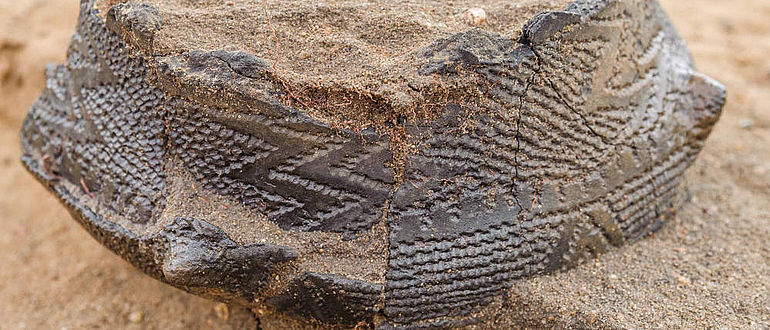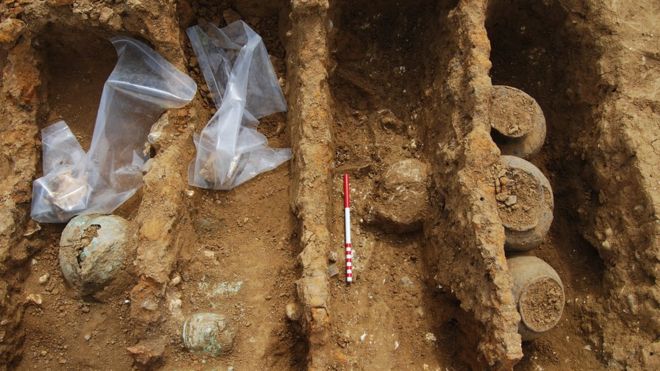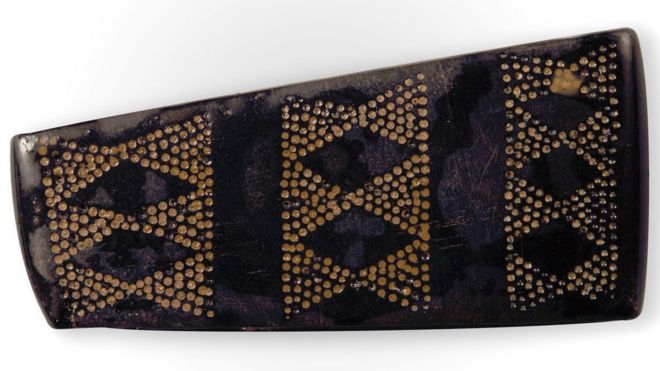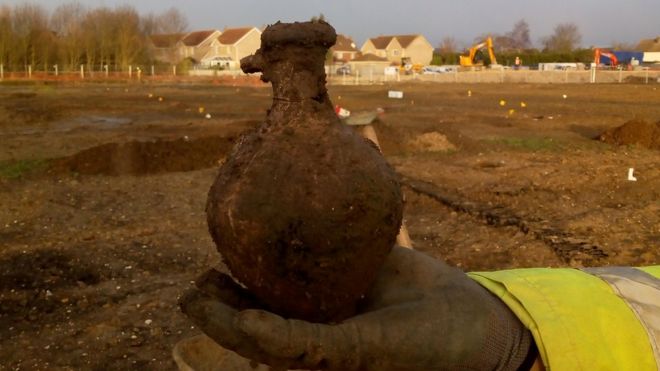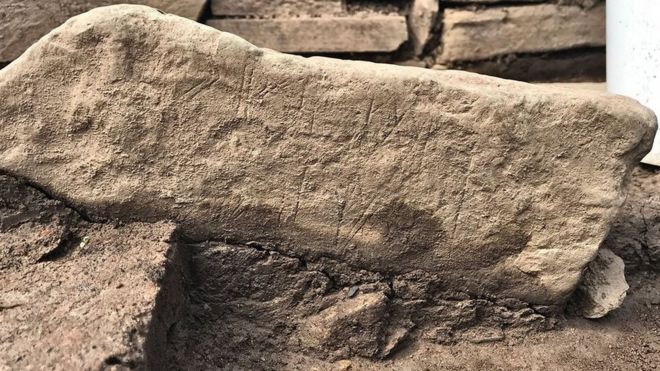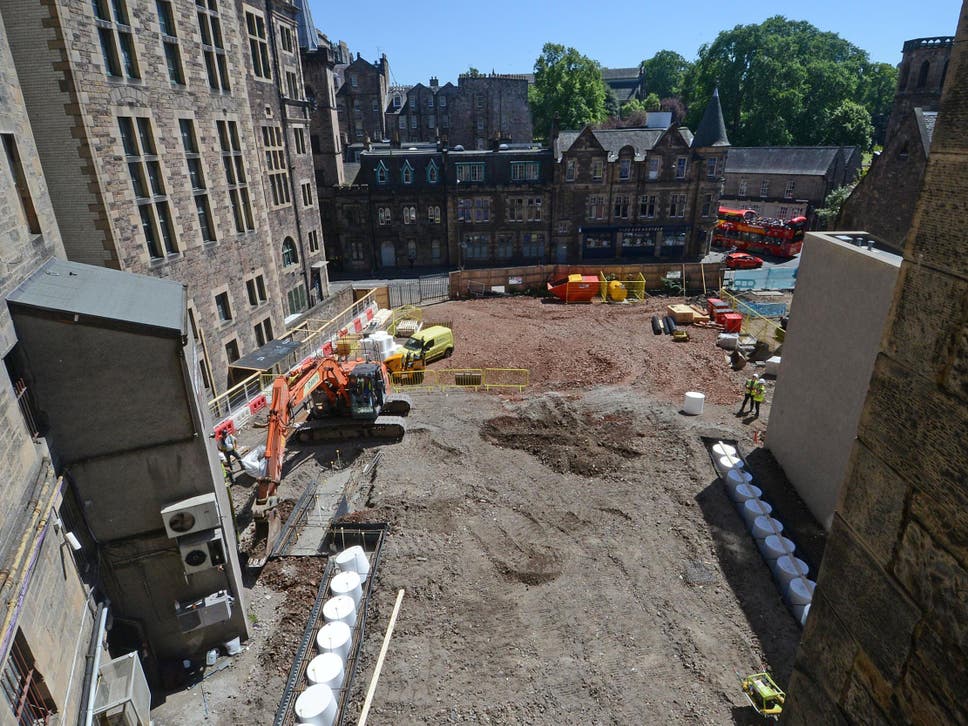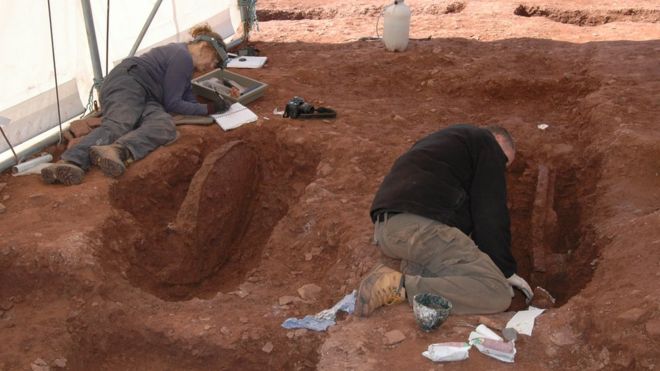The Prehistoric Archaeology Blog is concerned with news reports featuring Prehistoric period archaeology. If you wish to see news reports for general European archaeology, please go to The Archaeology of Europe Weblog.
Monday, July 29, 2019
Slovakia/Thousands of years old traces of human presence found in Tatra cave
Source: Prof. Paweł Valde-Nowak
Researchers including Polish archaeologists discovered 14-15 thousand years old traces of human presence in the Hučava Cave in the Belianske Tatras. These are stone blades used by hunters. Until now, no prehistoric items have been found in any of the Tatra caves.
The discovery was made in July by a Slovak-Polish archaeological expedition. The Hučava Cave (Hučivá diera) is located in the Belianske Tatras in Slovakia, on the slopes of Kobylí Vrch, at 937 m a.s.l. Excavations are being carried out both at the entrance and in the cavern chamber.
"We have discovered dozens of stone blades that have survived completely or in fragments, originally embedded on poles (that have not survived until our time). We recovered some of the blades from the remnants of a hearth" - says Prof. Paweł Valde-Nowak from the Institute of Archaeology of the Jagiellonian University in Kraków. Valde-Nowak leads the research project together with Dr. Marian Sojak from the Institute of Archaeology of the Slovak Academy of Sciences in Nitra.
Read the rest of this article...
10,000-year-old engraved 'pebble' found near Rome said to be earliest known lunar calendar
The 10,000-year-old pebble which is believed to be the oldest lunar calendar in the world
[Credit: Sapienza Universita di Roma]
[Credit: Sapienza Universita di Roma]
The oldest known lunar calendar may be an engraved pebble dating back to the Upper Palaeolithic found in Velletri, in the Alban Hills, south of Rome. The news has been announced by Flavio Altamura, a researcher at the Department of Antiquities of Sapienza University, who analyzed this enigmatic object in collaboration with the Superintendency for Archaeology, Fine Arts and Landscape in the Rome Metropolitan Area, the Province of Viterbo and Southern Etruria. The results of this study have been published in the Journal of Archaeological Science: Reports.
"The study reveals," explains Flavio Altamura, "that the notches were made over time using more than one kind of sharp cutting stone tool, as if they had been used for counting and calculating, or to store some kind of information over a period of time.”
Read the rest of this article...
Sunday, July 28, 2019
Finds from Celtic grave found in Zurich analyzed
Reconstruction of the grave with tree coffin [Credit: Amt für Städtebau, City of Zurich]
The tree coffin burial of a Celtic woman, which was discovered in March 2017 during construction work on the Kern school building, was examined by the Archaeology City of Zurich in an interdisciplinary evaluation. The bones and the unusual burial objects were carefully documented, salvaged, preserved and evaluated. Thus the grave can be assigned to the Late Iron Age around 200 BC. Of the artefacts that have been found, a string of glass beads in particular is unique in its form: it is fastened between two fibulae (clasps) and fitted with precious glass and amber beads.
The now completed interdisciplinary evaluation of the archaeology department of the city of Zurich paints a fairly accurate picture of the deceased. The examination of the skeleton and especially the teeth shows, among other things, that she died at the age of about 40, did little physical work during her lifetime and probably ate a relatively large amount of starchy or sweetened food.
Seltene Brandgräber aus der Steinzeit bei Wedringen
Im Zuge des Neubaus der Ortsumfahrung bei Wedringen, Ortsteil von Haldensleben, Ldkr. Börde, führt das Landesamt für Denkmalpflege und Archäologie Sachsen-Anhalt (LDA) derzeit archäologische Ausgrabungen durch. Auf dem aktuellen Abschnitt der Grabungsfläche wurden seltene Brandgräber der Rössener Kultur (ca. 6600–6450 vor heute) entdeckt. Die etwa 25 Grabgruben sind an der dunklen, aschigen Verfüllung gut in dem sie umgebenden Boden erkennbar. Als Beigaben in den Gräbern sind reich verzierte Gefäße sowie Beile und Äxte aus Felsgestein zu finden. Im näheren Umfeld der Brandbestattungen und ohne erkennbaren Befundzusammenhang deponierte Keramikgefäße lassen an ein noch nicht näher zu definierendes Ritual während der Bestattungszeremonie denken.
Read the rest of this article...
Rare relics of an Iron Age warrior who fought the Romans
The helmet and crest of the Iron Age warrior. Photo Allan HutchingsPhotography
As the Novium in Chichester prepares to display the late Iron Age Bersted Warrior and his possessions in January 2020, we talk to archaeologist James Kenny about one of the most spectacular warrior burials ever found in Britain
When archaeologists arrived to investigate a grave discovery on the site of a new housing development near Chichester in West Sussex, they had little idea what was awaiting them.
A large scale archaeological excavation had been taking place ahead of the development in 2008 at North Bersted, and when the grave was uncovered Chichester District Council’s archaeologist, James Kenny, was one of the first people to view it.
Read the rest of this article...
Iron Age warrior's remains to go on show in Chichester
The grave contained "significant" artefacts
Chichester District Council
The remains of an Iron Age warrior and his possessions - hailed as a "spectacular discovery" by archaeologists - are to go on display.
Weaponry and other artefacts were found alongside the ancient fighter during excavations at a site near Chichester, West Sussex.
It is thought the grave belonged to someone of high status.
The man, who may have fought alongside a Roman king, will be the centre-piece of an exhibition at a city museum.
A team from Thames Valley Archaeological Services found the grave on land at North Bersted, near Bognor Regis, in 2008.
Read the rest of this article...
Grave of 'real-life Asterix' who fought Caesar found amid trove of weapons and possessions in West Sussex
'Unique find': the artefacts have been carefully studied for the last decade CREDIT: PA
The grave of a real-life Asterix containing what is believed to be an ancient Gallic warrior who came to Britain and fought Julius Caesar has been discovered, archaeologists have announced.
The unique and highly-elaborate resting place was found on a West Sussex building site.
The Iron Age warrior, buried with his glamorous and ornate head-dress, is thought to have been a refugee French Gallic fighter who fled Julius Caesar's legionnaires as they swept across continental Europe in about 50BC.
Archaeologists have described the discovery, which will go on display at Chichester's Novium Museum in January 2020, as "the most elaborately equipped warrior grave ever found in England".
Read the rest of this article...
Tuesday, July 23, 2019
Isle of Man Round Mounds: 'Spectacular' 4,000-year-old jet necklace found
Sand on the beads from the burial site will be removed as part of the conservation process
MNH
MNH
A 4,000-year-old necklace has been uncovered during an archaeological dig on the Isle of Man.
The piece of jewellery, found in the west of the island, is made up of 122 "intricately" decorated jet beads each measuring between 1cm and 5cm.
Thought to have originated in Whitby, North Yorkshire it is the first of its kind to be found on the Isle of Man.
When fully assembled, the necklace was crescent-shaped and made from multiple strings.
Read the rest of this article...
'Important' Iron Age settlement found at Warboys dig
Roman finds include this jug and human remains, including six skeletons
Oxford Archaeology East
Oxford Archaeology East
Iron Age roundhouses, Roman burials and Saxon pottery have been discovered in a "hugely important and hitherto unknown settlement".
The seven month-long dig in Warboys in Cambridgeshire also uncovered "a rare example" of "early Saxon occupation mingled with the latest Roman remains".
Archaeologist Stephen Macaulay said: "We almost never find actual physical evidence of this."
The settlement reverted to agricultural use after the 7th Century.
"What makes this site really significant is we have evidence of early Saxon occupation mingled with the latest Roman remains," said Mr Macaulay, deputy regional manager for Oxford Archaeology East.
Read the rest of this article...
Friday, July 19, 2019
Stone tool changes may show how Mesolithic hunter-gatherers responded to changing climate
Reconstruction of a Mesolithic camp-site with a hunter in the front ready to fire an arrow
mounted with stone microliths [Credit: Ulco Glimmerveen]
As a result of warming occurring at a rate of ca. 1.5 to 2°C per century, hunter-gatherers in Europe during the Mesolithic era (approximately 11,000-6,000 years ago) experienced significant environmental changes, very similar to the ones we face today: rising sea levels, increased drought, plant and animal migrations and wildfires. Here, Crombé examined microliths, small stone arrowheads/barbs used in hunting, to see how their design and usage by Mesolithic hunter-gatherers shifted in conjunction with climatic and environmental changes.
Building on archaeological research from the last two decades, Crombé used Bayesian modelling to reveal potential correlations between 228 radiocarbon dates specific to Mesolithic sites along the southern North Sea basin and the different types and shapes of microliths (triangles, crescents, leaf-shaped and mistletoe-shaped microliths, trapezes, etc.) found at these sites.
Thursday, July 18, 2019
Archaeology Anthropology Palaeontology Evolution Exhibitions Natural Heritage Astronomy Out of Africa and into an archaic human melting pot
A map showing where the ancestors of modern humans appear to have met and mixed
with archaic hominins [Credit: University of Adelaide]
Genetic analysis has revealed that the ancestors of modern humans interbred with at least five different archaic human groups as they moved out of Africa and across Eurasia.
While two of the archaic groups are currently known - the Neanderthals and their sister group the Denisovans from Asia ¬- the others remain unnamed and have only been detected as traces of DNA surviving in different modern populations. Island Southeast Asia appears to have been a particular hotbed of diversity.
Published in the Proceedings of the National Academy of Sciences, researchers from the University of Adelaide's Australian Centre for Ancient DNA (ACAD) have mapped the location of past "mixing events" (analysed from existing scientific literature) by contrasting the levels of archaic ancestry in the genomes of present-day populations around the world.
Read the rest of this article...
with archaic hominins [Credit: University of Adelaide]
Genetic analysis has revealed that the ancestors of modern humans interbred with at least five different archaic human groups as they moved out of Africa and across Eurasia.
While two of the archaic groups are currently known - the Neanderthals and their sister group the Denisovans from Asia ¬- the others remain unnamed and have only been detected as traces of DNA surviving in different modern populations. Island Southeast Asia appears to have been a particular hotbed of diversity.
Published in the Proceedings of the National Academy of Sciences, researchers from the University of Adelaide's Australian Centre for Ancient DNA (ACAD) have mapped the location of past "mixing events" (analysed from existing scientific literature) by contrasting the levels of archaic ancestry in the genomes of present-day populations around the world.
Read the rest of this article...
Maternal secrets of our earliest ancestors unlocked
Australopithecus africanus impression by Jose Garcia and Renaud Joannes-Boyau, Southern Cross University
[Credit: Jose Garcia and Renaud Joannes-Boyau, Southern Cross University]
[Credit: Jose Garcia and Renaud Joannes-Boyau, Southern Cross University]
Analysis of more than two-million-year-old teeth from Australopithecus africanus fossils found in South Africa have revealed that infants were breastfed continuously from birth to about one year of age. Nursing appears to continue in a cyclical pattern in the early years for infants; seasonal changes and food shortages caused the mother to supplement gathered foods with breastmilk. An international research team led by Dr Renaud Joannes-Boyau of Southern Cross University, and by Dr Luca Fiorenza and Dr Justin W. Adams from Monash University, published the details of their research into the species in the journal Nature.
"For the first time, we gained new insight into the way our ancestors raised their young, and how mothers had to supplement solid food intake with breastmilk when resources were scarce," said geochemist Dr Joannes-Boyau from the Geoarchaeology and Archaeometry Research Group (GARG) at Southern Cross University.
"These finds suggest for the first time the existence of a long-lasting mother-infant bond in Australopithecus. This makes us to rethink on the social organisations among our earliest ancestors," said Dr Fiorenza, who is an expert in the evolution of human diet at the Monash Biomedicine Discovery Institute (BDI)
Read the rest of this article...
Stonehenge may have been built using pig fat
Fat residues on shards of pottery found at
Durrington Walls, near Stonehenge, have long been assumed to be
connected with feeding the many hundreds of people that came from across
Britain to help construct the ancient monument.
But, new analysis by archaeologists at Newcastle University, UK, suggests that because the fragments came from dishes that would have been the size and shape of buckets, not cooking or serving dishes, they could have been used for the collection and storage of tallow—a form of animal fat.
But, new analysis by archaeologists at Newcastle University, UK, suggests that because the fragments came from dishes that would have been the size and shape of buckets, not cooking or serving dishes, they could have been used for the collection and storage of tallow—a form of animal fat.
Dr. Lisa-Marie Shillito, Senior Lecturer in
Landscape Archaeology, Newcastle University, said: "I was interested in
the exceptional level of preservation and high quantities of lipids—or
fatty residues—we recovered from the pottery. I wanted to know more
about why we see these high quantities of pig fat in pottery, when the
animal bones that have been excavated at the site show that many of the
pigs were 'spit roasted' rather than chopped up as you would expect if
they were being
Read the rest of this article...
'Stunning' decorated Neolithic stone discovered in Orkney
The decorated stone was discovered on Monday
Ness of Brodgar
Ness of Brodgar
Archaeologists have uncovered what they describe as a "stunning example" of Neolithic decorate stone in Orkney.
The notch-marked slab was discovered at Ness of Brodgar, the location of a well-preserved and sophisticated complex of stone buildings.
The site was built and occupied by people more than 5,000 years ago.
Archaeological excavations began at Ness of Brodgar more than 15 years ago and the site covers an area of about six acres (2.5 ha).
The decorated stone was found on Monday, followed by further discoveries of smaller carved stones during the rest of the week
Read the rest of this article...
Thursday, July 11, 2019
A
reconstruction of Apidima 2, which was shown to be a Neanderthal skull.
A far older skull fragment, Apidima 1, was also assumed to be
Neanderthal, but scientists now say it belonged to a modern human.
CreditCreditKaterina Harvati, Eberhard Karls University of Tübingen
CreditCreditKaterina Harvati, Eberhard Karls University of Tübingen
The bone, found in a cave, is the oldest modern human fossil ever discovered in Europe. It hints that humans began leaving Africa far earlier than once thought.
A skull fragment found in the roof of a cave in southern Greece is the oldest fossil of Homo sapiens ever discovered in Europe, scientists reported on Wednesday.
Until now, the earliest remains of modern humans found on the Continent were less than 45,000 years old. The skull bone is more than four times as old, dating back over 210,000 years, researchers reported in the journal Nature.
The finding is likely to reshape the story of how humans spread into Europe, and may revise theories about the history of our species.
Read the rest of this article...
Wednesday, July 10, 2019
Cannonballs, skulls and jewellery: Archaeologists discover 'Bronze Age relics' in Edinburgh city centre, delaying Richard Branson’s new hotel
Building
of first Virgin Hotel in Britain has been delayed for a year after
archaeologists at the Edinburgh site unearthed artefacts dating back
1,000 years ( Jon Savage /SWNS )
The opening of Sir Richard Branson‘s first Virgin Hotel in Britain has been delayed by a year after archaeologists at the site unearthed artefacts dating back 1,000 years.
The excavation in Edinburgh has lasted more than a year, three times longer than expected, due to the range of objects and material discovered from the 10th century.
Experts say the remains of buildings found predate Edinburgh Castle and the creation of the town burgh by David I by around 200 years.
The work has also unearthed ditches and walls marking the original boundary of the city and some of the discoveries could date as far back as the Bronze Age.
Read the rest of this article...
The first Europeans weren’t who you might think
Genetic tests of ancient settlers' remains show that Europe is a melting pot of bloodlines from Africa, the Middle East, and today's Russia.
The idea that there were once “pure” populations of ancestral Europeans, there since the days of woolly mammoths, has inspired ideologues since well before the Nazis. It has long nourished white racism, and in recent years it has stoked fears about the impact of immigrants: fears that have threatened to rip apart the European Union and roiled politics in the United States.
Now scientists are delivering new answers to the question of who Europeans really are and where they came from. Their findings suggest that the continent has been a melting pot since the Ice Age. Europeans living today, in whatever country, are a varying mix of ancient bloodlines hailing from Africa, the Middle East, and the Russian steppe.
The evidence comes from archaeological artifacts, from the analysis of ancient teeth and bones, and from linguistics. But above all it comes from the new field of paleogenetics. During the past decade it has become possible to sequence the entire genome of humans who lived tens of millennia ago. Technical advances in just the past few years have made it cheap and efficient to do so; a well-preserved bit of skeleton can now be sequenced for around $500.
The result has been an explosion of new information that is transforming archaeology. In 2018 alone, the genomes of more than a thousand prehistoric humans were determined, mostly from bones dug up years ago and preserved in museums and archaeological labs. In the process any notion of European genetic purity has been swept away on a tide of powdered bone.
Read the rest of this article...
Thursday, July 4, 2019
Late Iron Age chariot pieces found in Pembrokeshire
Archaeologists discovered bronze artefacts, the iron tyres of the chariot wheels and an iron sword
MUSEUM WALES
Archaeologists have discovered more artefacts at the first Celtic chariot burial site to be found in southern Britain.
Two iron tyres and a sword from the chariot were retrieved during an excavation in Pembrokeshire.
The exact site remains a secret and follows the discovery of decorative objects by a metal detector enthusiast on the same land in February 2018.
National Museum Wales is conserving the chariot pieces.
Archaeologists had suspected they would uncover more beneath the farmland where metal detectorist Mike Smith found a number of objects associated with a chariot.
Following an initial investigation in June 2018 by archaeologists from National Museum Wales and Dyfed Archaeological Trust, a dig was carried out in March and April, funded by National Museum Wales, Cadw and the National Lottery Heritage Fund.
Read the rest of this article...
Ancient Humans Dietary Habits Reflected In Bonobo Aquatic Greens Diet
Bonobos have been spotted doing something interesting in the Congo basin. They are scouring the swamp in search of aquatic herbs that are packed with iodine, a nutrient that is very important for advancing the growth of higher cognitive abilities. That could help scientists understand the nutritional needs and practices of ancient humans. The Bonobo consumption of food rich in iodine is the first-ever recorded by a species other than humans.
“Our results have implications for our understanding of the immigration of prehistoric human populations into the Congo basin,” Dr. Gottfried Hohmann, the lead author of the study comments.
“Bonobos as a species can be expected to have similar iodine requirements to humans, so our study offers—for the first time—a possible answer on how pre-industrial human migrants may have survived in the Congo basin without artificial supplementation of iodine,” the researcher added.
Read the rest of this article...


